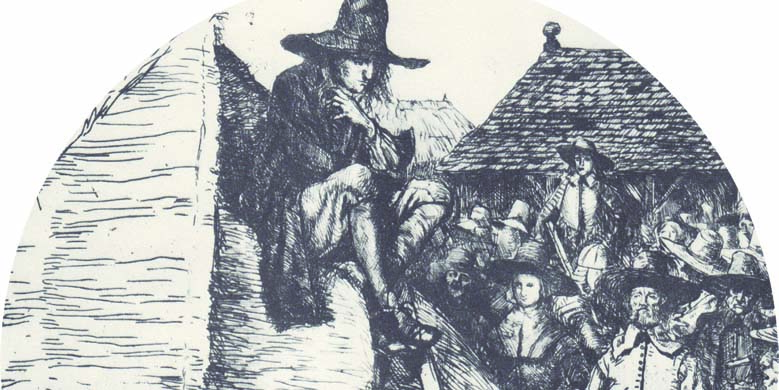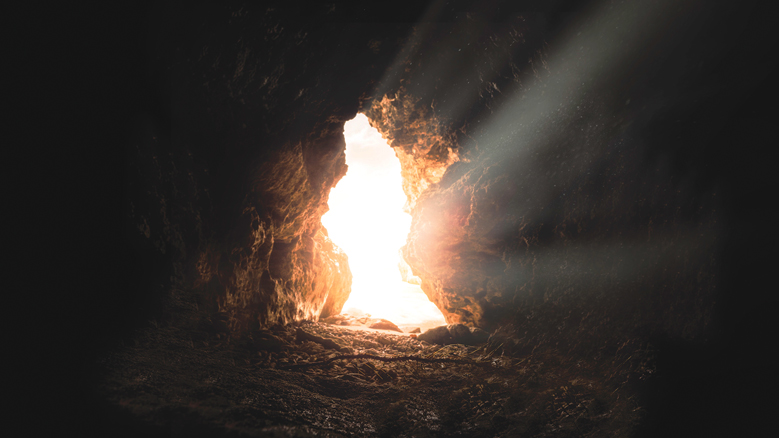Quakers do not get religion secondhand, but aim always to be experiential, to wait upon the Light, and then to walk in the Light. Yet religious experience is not raw data. It is interpreted data. The interpreter may be an individual or, often with Quakers, an individual in a group, say in a clearness committee or a meeting for worship. In addition, the individual and the local group are always embedded in a larger culture, and the culture supplies much of the scaffolding for interpreting religious experience. This was also true for George Fox. It is clear from his Journal that he interpreted his own religious experience according to tenets derived from 16th-century Protestantism.
George Fox believed the Light he knew was Christ—the risen Jesus. He believed Jesus had been crucified at the crossroads of God’s salvation history, which unfolded as follows: God created the universe and Earth, all the animals, and the first people, Adam and Eve, and created them perfect. Soon after their creation, the primordial couple sinned, thereby degrading their perfect nature and the nature of humanity. Jesus’ crucifixion was a sacrifice that paid the penalty for Eve and Adam’s sin. Because of Jesus’ sacrificial deed, people are able to return to the uncorrupted, perfect state of the pre-fallen Adam and Eve by walking according to the Spirit of Christ. Through that same Spirit, we are able to interpret Scripture correctly and, therefore, to know the Truth that comes from God. These are George Fox’s beliefs as he expresses them throughout his Journal, and except for his perfectionism, they are orthodox Protestant beliefs from the 16th century.
We now know that George Fox’s Protestant predecessors misinterpreted Scripture. Instead of carefully reading Genesis 3 for himself, George Fox repeated what he had heard about it, which came from Martin Luther and John Calvin and, ultimately, from Augustine of Hippo. He heard that God created Eve and Adam perfect. The idea of their perfection comes from Genesis 1 where God pronounces all creation good, and where the first couple do not sin—they have no occasion to sin because they may eat of all the fruit of all the trees (Gen. 1:29). The idea that Adam and Eve were perfect upon creation also comes from philosophical theology, which declares God omniscient, omnipotent, and omniben-evolent, so that logically God’s creation had to have been perfect originally. Only an older, separate narrative related in Genesis 2 and 3 says God forbids eating the fruit of the tree of knowledge (Gen. 2:17).
George Fox assumed that eating the forbidden fruit corrupted our once-perfect nature. However, scholars of the Hebrew Scriptures now agree that the narrative of Genesis 3 never indicates that Eve and Adam’s deed corrupts human nature. In fact, the narrative says that Adam and Eve improve upon eating the fruit (Gen. 3:7), which many theologians seem to have missed. Later in the narrative God explicitly declares that they have gained knowledge by eating the fruit (Gen. 3:22). So according to Scripture the first sin, the original sin, does not have the consequences that later theologians thought and that George Fox believed. In this ancient narrative, Eve and Adam cannot have been created perfect, for they gain perfection as they go. Indeed their imperfection at their creation is implied earlier, when God uses mud to create Adam. Their vulnerability to the serpent’s seduction proves them to be imperfect, too. Their original imperfection and their improvement from eating the fruit of knowledge means that Jesus’ crucifixion cannot logically have been recompense for Adam and Eve’s sin because there were no consequences of their sin that degraded human nature. Nor could Jesus have enabled the re-perfection of human nature, as George Fox believed, because it was not perfect in the first place.
Furthermore, today we have access to another creation story than the one available in George Fox’s culture, which was based on ancient texts. Our creation narrative is the scientific saga, a story far more congruent with evidence and mathematical logic than the scriptural narrative. Our creation story begins some 13.7 billion years ago with the Big Bang that marks the creation of our material universe. From that beginning, hydrogen and helium eventually form. Gravity pulls globs of these gasses so tightly together the nucleons fuse, generating stars and galaxies. The fusion and explosion of the stars creates the heavier elements—the carbon, oxygen, nitrogen, and trace elements of which our bodies are composed. We now know that we are stardust and that our blood is salt water descended from and resembling Earth’s seas of more than 3 billion years ago.
We are not alienated exiles, as liberal interpreters of Genesis claim. Instead we are intimately integrated with the universe. We are slivers of the stars. We are salt of the Earth. Having evolved here, we are also kin to other organisms, sharing a common history and common chemistry with all that lives. We are also closely related to many other animals in our anatomy and physiology.
Periodically scientists add chapters to the scientific saga. One of the most recent chapters is sociobiology, the scientific study of animal social behavior based on genetics. Because we are social animals, sociobiology studies us, too.
Like Genesis 2 and 3 and the theologians who misread the narrative, sociobiology provides us with a model of human nature. Like all scientific models, this model of human nature is simplified, but it captures the basics by giving us scientific evidence for what we already know from common observation. Sociobiology says human life revolves around gaining re-sources, reproducing, caring for kin, and engaging in reciprocity—money, sex, nepotism, and exchange. (In some industrialized countries nepotism is partially hidden because monogamous, capitalist society discourages it as unfair and unproductive, but it is vividly evident elsewhere, especially in polygamous and tribal societies.)
Our evolution from other animals tells us that Eve and Adam never existed and therefore cannot be the cause of our sinfulness. Looking at our animal heritage, many people claim that our sinfulness springs from our animal ancestors—we are "brutes," just as they are. However the other "brutes"—cats, dogs, monkeys, bears, deer, and squirrels—do not cause much harm. Indeed most "brutes" are innocent vegetarians. We human beings are the brutal ones.
Why? We are capable of so much evil because our capacities are so much greater than those of other animals. Our ability to manipulate symbols enables us to communicate as no other animal can. Thus we cooperate as few other animals do—cooperate to create and to destroy, to construct communities and to gather armies. We are moved by symbols like the flag for which we are willing to sacrifice ourselves—or others. Our remarkable creativity enables us to design exquisite artwork and architecture as well as increasingly lethal weapons and excruciating tortures. Those very characteristics we admire, our proud virtues, the attributes that make us human, enable us to do evil. We cannot separate ourselves from our potential for evil without ceasing to be human.
Thus George Fox’s dream of a return to the perfection of pre-fallen Adam and Eve is an illusion. Our nature now is as perfect as it can be. We ourselves choose to use our remarkable attributes for good or evil. In our choice for good, the same Light that illuminated George Fox’s life aids us.
George Fox equated that Light with the risen Christ. However, if we are looking for a pattern for our lives, we might turn instead to the historical Jesus, Jesus the man who lived and died here on Earth. Most New Testament scholars think uncovering the historical Jesus means setting aside the Quakers’ beloved Gospel of John, which mostly portrays the risen Christ the early church knew, and focusing on the Synoptics: on Matthew, Mark, and Luke. Their Jesus shows us what living a life of atonement is like. Atonement—at-one-ment—means unity with God, walking in the Light here and now.
Interestingly Jesus shows us how to deal with those desires sociobiology uncovers as basic, as deeply a result of our evolution—desires for resources, reproduction, reciprocity, and the nepotism kinship brings. Mostly he tells to treat them lightly. On resources he says to consider the lilies of the field and not place our faith in wealth. He lives his message by being an itinerant with few possessions. Toward sex he seems to have a take-it-or-leave-it attitude. He does not marry, but his most prominent disciple, Peter, has a wife. He does not castigate people for their sexual sins, but he tells them to cease. Jesus even tends to denigrate reciprocity. Instead he praises giving without receiving and forgiving without recompense. He also demotes kinship from the high place it held in the first century. He rejects his family in favor of his disciples and disparages the tribal dreams of his Jewish contemporaries who hoped the expected messiah would restore the twelve Jewish tribes to the land from which ten had vanished in exile (the renowned lost tribes of Israel).
Rather than encouraging us to follow our evolved desires, he says to seek God. God is here, now, he says in the parables. God’s realm is small and hidden, but worth seeking tirelessly, for it is more valuable than all other things.
Evidently Jesus lived in the Light. His crucifixion did not make atonement for Eve and Adam’s sin. Rather he lived a life of at-one-ment, of unity with God, as he walked the Earth alive. He shows us how to do the same.
George Fox’s Journal reveals that he lived by the same Light. Indeed Jesus and George Fox are remarkably alike, for all their difference in century and culture. George Fox is an itinerant, also, caring so little for the goods of this world that he tells Margaret Fell—soon to become Margaret Fox—he does not want a part in her considerable estate. He, too, sleeps outdoors in all weather, reliving Jesus’ comment that he (Jesus) has nowhere to lay his head. George Fox, too, tells all and sundry that Christ’s (God’s) reign is here and now, that one need not await an external Second Coming. George Fox, too, gives freely, most notably of his body to his enemies to beat and imprison so they might see his love for them and turn to Love.
George Fox’s intellectual interpretation of his religious experience was not similar to Jesus’ interpretation of his, for Jesus thought within the framework of first-century Judaism. Given the scaffolding that science, history, and critical reading of the Bible provide to our culture, our best interpretation of our own experience will differ from either of theirs. But their different interpretations did not keep them from walking cheerfully over the world in the Light, and our different interpretation should not keep us from doing so. Indeed, in these two people we see the power of that Light to enlighten all people, whatever their culture. We also see the importance of giving to our religious experience the best interpretation available in our culture, as they did in theirs. In ours, a best interpretation cannot ignore science, history, or critical reading of the Bible. Certainly it will demand doing without Adam and Eve.
——————
This article is based on her book, Doing without Adam and Eve: Sociobiology and Original Sin (2001). See http://www.theologyauthor.com.



